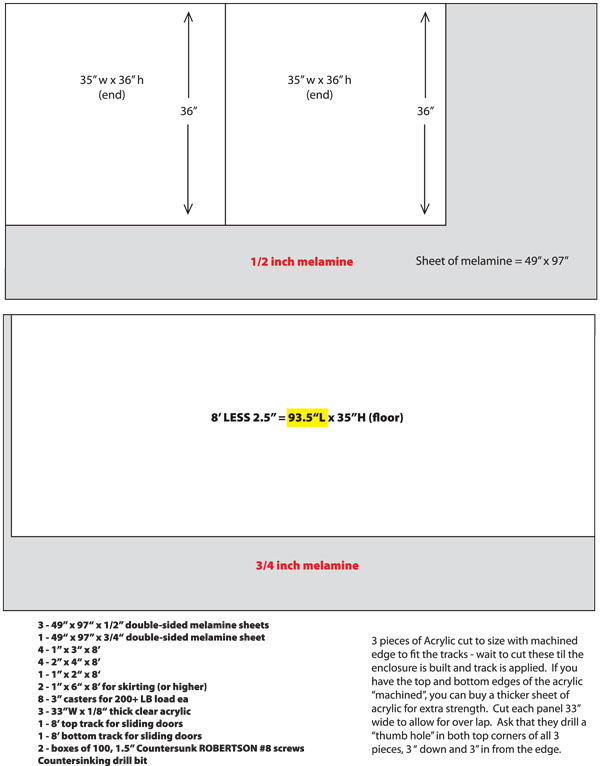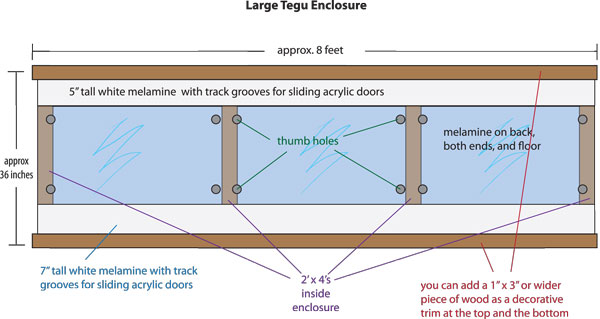Your check list for tegu enclosure material and how to put it all together.
The most common questions we at Tegu Topia get are: "How do I build an enclosure large enough for my Tegu?” And "What size enclosure will I need?” Unless you’re a cabinetmaker or you have the extra money to hire a cabinetmaker to build you a show piece, you’ll need to build your own enclosure.

Make sure you have all your materials before you start..
We prefer to use the white, double-sided melamine boards. They come slightly larger than a 4-foot-by-8-foot sheet of plywood, in several thicknesses, and they are readily available at the do-it-yourself big box stores. We use a half-inch thickness for the walls, top, and the header and footer on the front of the enclosure (where the track attaches). And we use a three-fourth-inch thickness for the floor.

Gather Your Materials
You will need the following to build an enclosure that measures 3 feet tall, 3 feet wide and 8 feet long:
Three sheets of white, half-inch-thick, double-sided melamine, measuring 49 inches by 97 inches
One sheet of white, three-fourth-inch thick double-sided melamine, measuring 49 inches by 97 inches
Four sheets of white, 1-inch-thick, double-sided melamine, measuring 3 inches by 8 feet
Four sheets of white, 2-inch-thick, double-sided melamine, measuring 4 inches by 8 feet
One sheet of white, 1-inch-thick, double-sided melamine, measuring 2 inches by 8 feet
Two sheets of white, 1-inch-thick, double-sided melamine, measuring 6 inches by 8 feet, for skirting (might need to be higher depending on your wheels)
Eight 3-inch casters/wheels for a 200-plus pound load each (swivel ones work much better)
Three pieces of 33-inch wide by one eighth of an inch thick clear acrylic (height unknown until the enclosure is built)
One 8 foot long top plastic track for sliding doors (two grooves)
One 8 foot long bottom plastic track for sliding doors (two grooves)
Two boxes of 100, 1 ½-inch countersunk Robertson Number 8 screws
One countersinking drill bit
One tube of white acrylic bathtub caulking (more depending on where you’re caulking), a drill, a screwdriver, a caulking gun and a plastic smoother.

Come Prepared
When we build a new large enclosure, we bring our "cutting sheets” with us to the store. (Are these like a paper template?) We ask that they cut all the pieces for us. They usually charge us $1 per cut for approximately half the cuts. This allows for the cuts to be straight, multiple pieces to be exactly the same size, the cut pieces are much easier to handle and transport home than the large sheets, and the enclosure is ready to start building right out of the truck.
You Will Need The Following To Complete The Habitat:
1 – extendable closet hanger rod
1 – approx. 9” wide reptile light fixture with hanger that will allow for a 160 watt bulb
2 – 160 watt MVBs (1 is for a spare)
24 – interlocking bricks to make a 3’ x 3’ patio (+/– depending on your brick shape/size)
1 – bale of wheat straw (or other suggested substrate)
1 – approx. 14” H x 19” W x 32” L clear plastic tote with a lid that latches, and medium
Any decorations should be heavy duty and may need to be glued in place.
What Everyone Needs To Keep An Adult/Sub-Adult Tegu:
To keep a healthy, happy Tegu indoors, you’ll need the following supplies:
• 3’H x 3’W x 8’L sturdy enclosure (on wheels works wonders)
• Size-appropriate hide box with lid that latches (larger is better, but don’t go crazy)
An approx. 14”H x 19”W x 32”L clear plastic tote works great!
• Hide box medium/substrate (a mix of small-chip coco husk and Sphagnum moss)
• Enclosure substrate (wheat straw, coco husk, pure cypress mulch, ReptiBark, etc.)
• Large, flat basking rock or 3’ x 3’ brick "patio” (we use interlocking bricks)
• Clean, heavy, water bowl (some say large enough for the Tegu to soak in)
• Clean, heavy, food bowl (we use the crock-style ceramic bowls for both)
• Large reptile light fixture with hanger
• 2- 160 watt MVBs (Mercury Vapour Bulb). Provides heat, light, and UVB (1 is a spare)
• 2 Reptile light bulbs, 2 UVB bulbs, AND 2 hanging light fixtures (if not using MVBs)
• Temperature gauges (a stick-on ambient thermometer for both ends, and something to
read the temp at the basking site)
• Mister/fogger to put humidity into the enclosure itself
• Hygrometer to measure humidity (don’t put it in the hide box)
• Misting bottle (we prefer the one that you pump and then it sprays for several seconds)
• Large plastic food scoop (for cleaning the enclosure)
• Dish scrub brush, scrubbie, and antibacterial dish soap (for cleaning dishes)
• Paper towels and environmentally friendly Glass cleaner (to be safe for your Tegu)
• 2 hand towels (of different colours)
• Hand sanitizer (in a pump bottle is easier)
• Polysporin (or Neosporin), Hibitane, and Peroxide (for wounds
• Tear Gel (in case your Tegu gets something in its eyes)
• Non-toxic enclosure cleaner (we use Nolvasan)
• Surge-protected power bar with programmable timer and battery for the clock (keeps
the program in memory even after a power outage), and a spare battery
• Daily spot cleaning
• Time and patience
• Human interaction and respect
• And, of course, love



